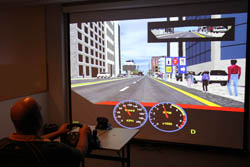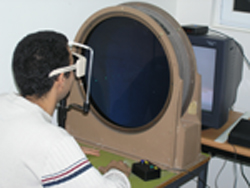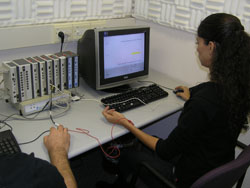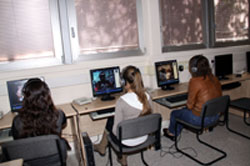Road Safety Laboratory
 Do road signs (billboards) affect driving behavior? That is the question that the unit is trying to answer in a study in progress supported by the Road Safety Authority. Do such signs distract the drivers' attention and how are the drivers' responses to critical events affected? In a newly acquired driving simulator the driving behavior and eye-movements of drivers are monitored to examine the effects of static and dynamic (video) billboards on their responses to various events that normally occur in the course of driving.
Do road signs (billboards) affect driving behavior? That is the question that the unit is trying to answer in a study in progress supported by the Road Safety Authority. Do such signs distract the drivers' attention and how are the drivers' responses to critical events affected? In a newly acquired driving simulator the driving behavior and eye-movements of drivers are monitored to examine the effects of static and dynamic (video) billboards on their responses to various events that normally occur in the course of driving.
Research projects:
Perceptual Load in Central and Peripheral Regions and its Effects on Driving Performance with and without Collision Avoidance Warning System.
Perceptual Load in Central and Peripheral Regions and its Effects on Driving Performance with and without Advertisement Billboards.
The Effect of Billboards on Driving as a Function of Billboard Type and Size.
Automatic Enforcement Methods: Overt vs. Covert Speed Cameras and Optimal Conditions for their Deployment.
Developing Optimal Markings for Crosswalks.











 In the Stereoscopic Vision and Perception Lab we conduct studies to test whether stereoscopic displays improve human performance in different tasks. Stereoscopic displays present two images taken from slightly different angle, to each eye seperately. This technology yields depth perception which is similar to that obtained through natural perception.
In the Stereoscopic Vision and Perception Lab we conduct studies to test whether stereoscopic displays improve human performance in different tasks. Stereoscopic displays present two images taken from slightly different angle, to each eye seperately. This technology yields depth perception which is similar to that obtained through natural perception. A computerized lab that includes MP100 System hardware which provides a flexible tool for research. The system is modular, and has powerful interface system that can be used with other BIOPAC amplifiers and accessories.
A computerized lab that includes MP100 System hardware which provides a flexible tool for research. The system is modular, and has powerful interface system that can be used with other BIOPAC amplifiers and accessories. A research lab that is used mainly for teaching and training.
A research lab that is used mainly for teaching and training.